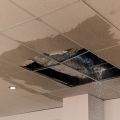Common Causes of Flooding Toilets

Flooding toilets are an unwelcomed sight for any home or business owner. Aside from potential health concerns, there is also the trouble of an increasing water bill.
Toilet overflows usually require professional intervention, as the water involved may be harmful and the damage sustained widespread. Before responding to the situation, it is important to understand the common causes of toilet flooding and how to prevent them.
What Causes a Toilet Overflow?
Toilets and their corresponding sewer systems operate on the principle of gravity to remove sewage. Overflows and flooding occur when something prevents this system from working properly.
Blockages A clog in the system is preventing sewage from being flushed.
Damage in the water line
Broken water pipes can cause a massive amount of water to flood the bathroom, which could escalate in a matter of moments if the shutoff valve is not closed in time.
Damage in the sewer line
A blocked, broken or cracked sewer line will not allow sewage to drain properly. When this happens, sewage backs up the sewer line and re-enters the property through the lowest possible point, which is most often be a basement toilet.
Shower leak
Leaks can form if a shower's foundation is compromised. These leaks can flood a bathroom, cause mold growth and result in seepage in the subfloor.
Defects in the plumbing
Toilets can overflow if there are defects in the plumbing system, such as a stuck flush handle or a tank float mechanism not working properly.
If your toilet runs constantly, this typically indicates a malfunction in the toilet tank's internal components. Fortunately, these problems can be easy to diagnose and solve. ServiceMaster Restore has some tips below.
- Adjust the fill valve or ballcock to reduce the amount of water entering the tank if the water is continuously escaping down the overflow tube.
- Check the flapper to ensure that it is not chipped, hardened, or worn. Inspect the chain that is coming off the flapper to make sure that it is not caught or tangled and has adequate slack to allow the flapper to automatically close after the release of the handle.
- Check the flush valve for signs of roughness or erosion, which may allow water to slowly drain into the bowl and cause the tank to be refilled periodically.
- Ensure that the flush lever is tightly secured and is in good working condition. This includes the toilet handle and the arm located in the interior of the tank.
Don't wait for a toilet overflow to cause major issues before you contact the professionals! Call ServiceMaster by Wright today.
ServiceMaster by Wright's Water Damage Restoration and Repair Process
- Contact ServiceMaster by Wright
- Inspection and Assessment
- Water Extraction
- Structural Drying and Dehumidification
- Cleaning and Disinfection
- Restoration and Repairs
- Reconstruction if Necessary
Schedule an Appointment with a Professional Water Damage Restoration Company Today
ServiceMaster by Wright is on-call 24 hours a day, 7 days a week at (239) 431-9947. We service residential and commercial properties in Bonita Springs, Bradenton, Cape Coral, Captiva, Englewood, Estero, Fort Myers, Iona, LaBelle, Lehigh Acres, Longboat Key, Marco Island, Naples, North Port, Port Charlotte, Punta Gorda, San Carlos Park, Sanibel Island, Sarasota, Siesta Key, and Venice, Florida.
- We offer FREE inspections and estimates.
- We offer online appointment scheduling.
- Our main office is located in 6451 Arc Way, Fort Myers, FL 33966.
- Visit our website for the addresses of our other Southwest Florida locations.
Don't know what to do next? We do. Contact ServiceMaster by Wright today.
Related items:
 11/4/2021
How to Properly File an Insurance Claim
11/4/2021
How to Properly File an Insurance Claim
 6/21/2021
Signs of Ceiling Water Damage in Southwest Florida
6/21/2021
Signs of Ceiling Water Damage in Southwest Florida
 9/27/2021
Condominium Water Damage Restoration Services in Fort Myers, FL
9/27/2021
Condominium Water Damage Restoration Services in Fort Myers, FL
 8/25/2021
What Business Documents Do We Need to Protect?
8/25/2021
What Business Documents Do We Need to Protect?